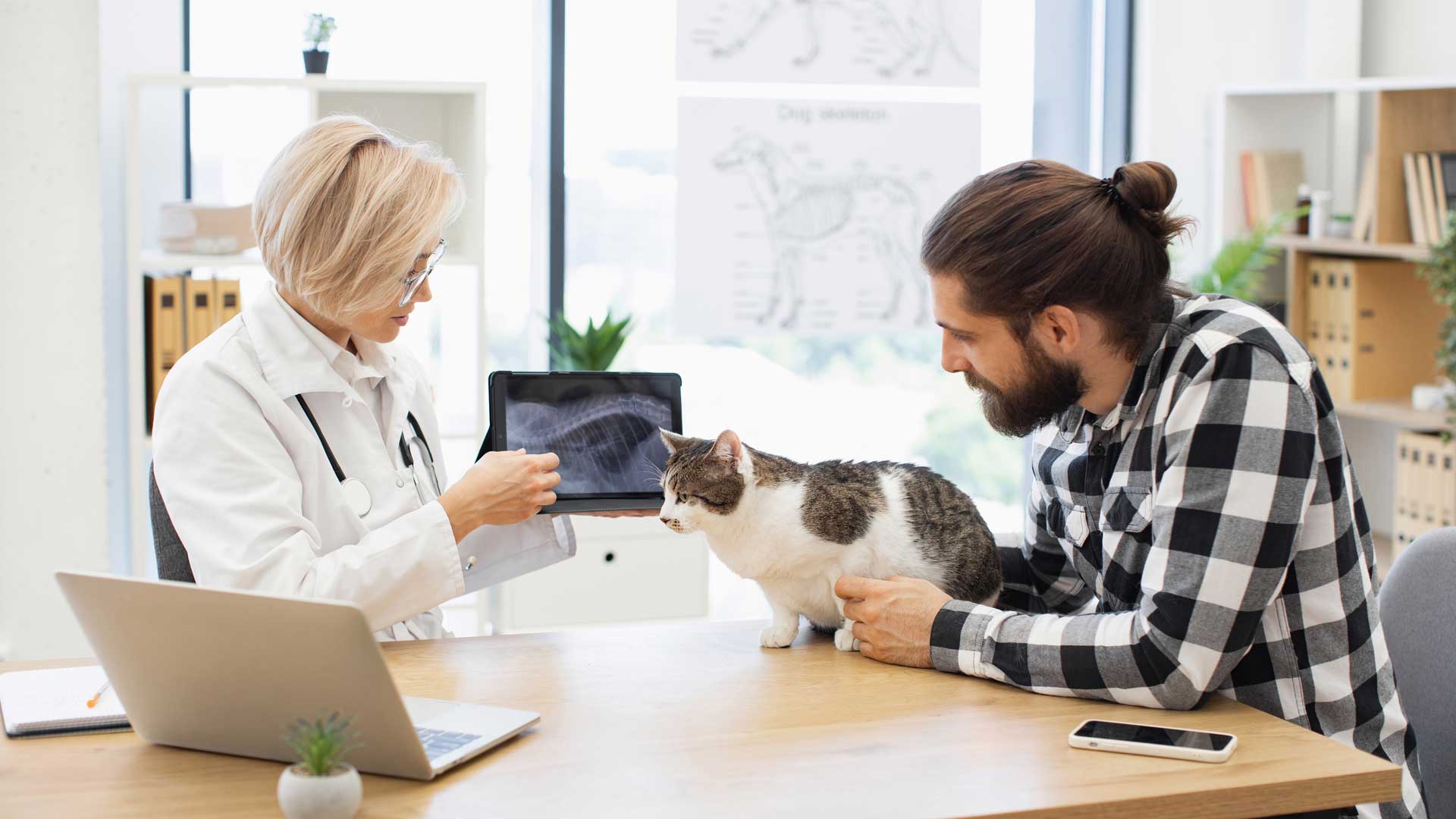X-rays for dogs and cats: what every new pet owner should know
X-rays are a powerful diagnostic tool that helps veterinarians see what’s going on inside your pet’s body, such as bones, joints, or even internal organs. They’re often used to check for injuries, locate swallowed objects, or investigate symptoms like limping or vomiting. At Banfield, our veterinary teams use modern equipment and safe techniques to keep your pet comfortable and minimize radiation exposure. We’re here to help guide you through the process and make it as simple, clear, and stress-free as possible.
What is a pet X-ray and how does it work?
A pet X-ray is a quick, non-invasive way to capture images of your pet’s bones, joints, and select internal organs. It works by using a small amount of radiation to create a snapshot of what’s happening inside the body. Most Banfield locations use digital radiography, which delivers high-quality images quickly, so our veterinarians can review and interpret them right away or send them out for a specialty consultation. Unlike MRIs or ultrasounds, which are better for soft tissue detail or moving images, X-rays may be more ideal for spotting things like fractures, arthritis, and foreign objects.

What health problems can an X-ray diagnose?
X-rays help veterinarians get a clearer look at what’s going on beneath the surface. They’re commonly used to diagnose broken bones, joint issues like arthritis, tumors or abnormal growths, swallowed objects, fluid in the lungs, and even confirm pregnancies. For example, if your pet is limping, an X-ray can help your vet determine whether it’s a simple sprain, fracture, or more serious joint condition. It’s a valuable tool that helps guide treatment.
Are X-rays safe for pets?
Yes, X-rays are considered safe for pets. The amount of radiation used is extremely low and carefully controlled, and modern equipment helps minimize exposure even further. Whether your pet is young, a senior, pregnant, or managing an illness, veterinarians take extra precautions to keep them safe and comfortable during the process. Our teams follow strict safety protocols — including shielding and positioning techniques — to protect both pets and staff during every imaging session.
What happens during a dog or cat X-ray?
During a pet X-ray, your vet team will gently position your dog or cat to get the clearest images possible. Some pets may need sedation or anesthesia to help them stay still and calm, especially if they’re anxious or in pain. Our teams perform the imaging with great care, using safety equipment to protect your pet and ensure accurate results. While you won’t be able to stay in the room during the X-ray (for your own safety), your pet will be in calm, capable hands the entire time.
Does my pet need sedation or anesthesia?
We may recommend sedation or anesthesia for X-rays if your pet is anxious, in pain, or needs to stay very still for clear images. It helps reduce stress, prevent sudden movements, and ensure a safe, comfortable experience, especially during more complex or sensitive imaging. Our veterinarians follow strict safety protocols, including tailored plans for senior pets and brachycephalic (short-nosed) breeds like Bulldogs and Pugs. If your pet is sedated or anesthetized, mild grogginess is the most common side effect, and most pets bounce back within a few hours with plenty of rest and water.

How much does a pet X-ray cost?
The cost of a pet X-ray in the United States generally ranges from $75–$600. Costs vary depending on factors like the number of images needed, whether sedation is used, and if a radiologist is consulted to interpret the results. While X-rays may seem expensive, they include specially trained staff, advanced digital equipment, safety protocols, and detailed image analysis, which are all essential for accurate diagnosis and care.
Banfield offers Optimum Wellness Plans® to help make preventive petcare more affordable. Special Care plans include a certain number of preventive X-rays in their yearly package, and other wellness plans offer a discount on this service. Learn more about OWP.

Get price estimate
FAQs on pet X-rays for pet owners
Can I stay with my pet during an X-ray?
For safety reasons, pet owners can’t be in the room during an X-ray. Rest assured, trained veterinary professionals stay with your pet the entire time and make the process as gentle and quick as possible.
How long does a pet X-ray take?
Most X-rays take about 10 to 30 minutes, depending on your pet’s condition and whether sedation is needed. It may take extra time if multiple views are required or if your pet needs help staying still.
What can an X-ray show in a dog?
X-rays may reveal broken bones, joint issues like arthritis, foreign objects, digestive blockages, lung problems, and even signs of dental disease. They help your vet see what’s going on inside your dog without surgery.
Can an X-ray detect cancer or blockages?
Yes, X-rays can often detect tumors, abnormal masses, or signs of organ enlargement that may point to cancer. They’re also commonly used to find blockages in the digestive system caused by things like swallowed toys or bones.
Are follow-up X-rays usually necessary?
Sometimes. Follow-up X-rays can help monitor healing, track the progress of a condition, or see how a treatment is working. Your vet will let you know if and when they’re needed.
Is sedation always required?
Not always. Sedation is used if your pet is anxious, in pain, or needs to stay very still for clear images. Sometimes, if a pet is calm and cooperative, they can have X-rays done without sedation.
Are there home X-ray options?
At-home X-rays for pets aren’t currently available, as they require specialized equipment and safety protocols. For accurate and safe imaging, it’s best to have X-rays performed by trained veterinary professionals in a clinic.
How soon do I get the results?
In many cases, your vet can review X-rays and discuss results with you the same day. If a radiologist review is needed, it may take a little longer, but your vet will keep you updated every step of the way.
Is it worth doing an X-ray if symptoms come and go?
Yes, intermittent symptoms can still signal underlying issues like joint problems, GI blockages, or lung conditions. An X-ray can help catch things early, even if your pet seems fine in between flare-ups.
Are you ready to protect your pet?
Book your pet’s imaging appointment today. Find a Banfield vet near you
Published August 29, 2025
The information provided on this page is for informational purposes only and is not a substitute for professional veterinary advice. Always consult a veterinarian with any questions regarding your pet's health or medical condition. Never disregard or delay seeking professional veterinary advice based on information from this page.
 Mites and mange
Mites and mange Podcast - Not Just Fluff
Podcast - Not Just Fluff
